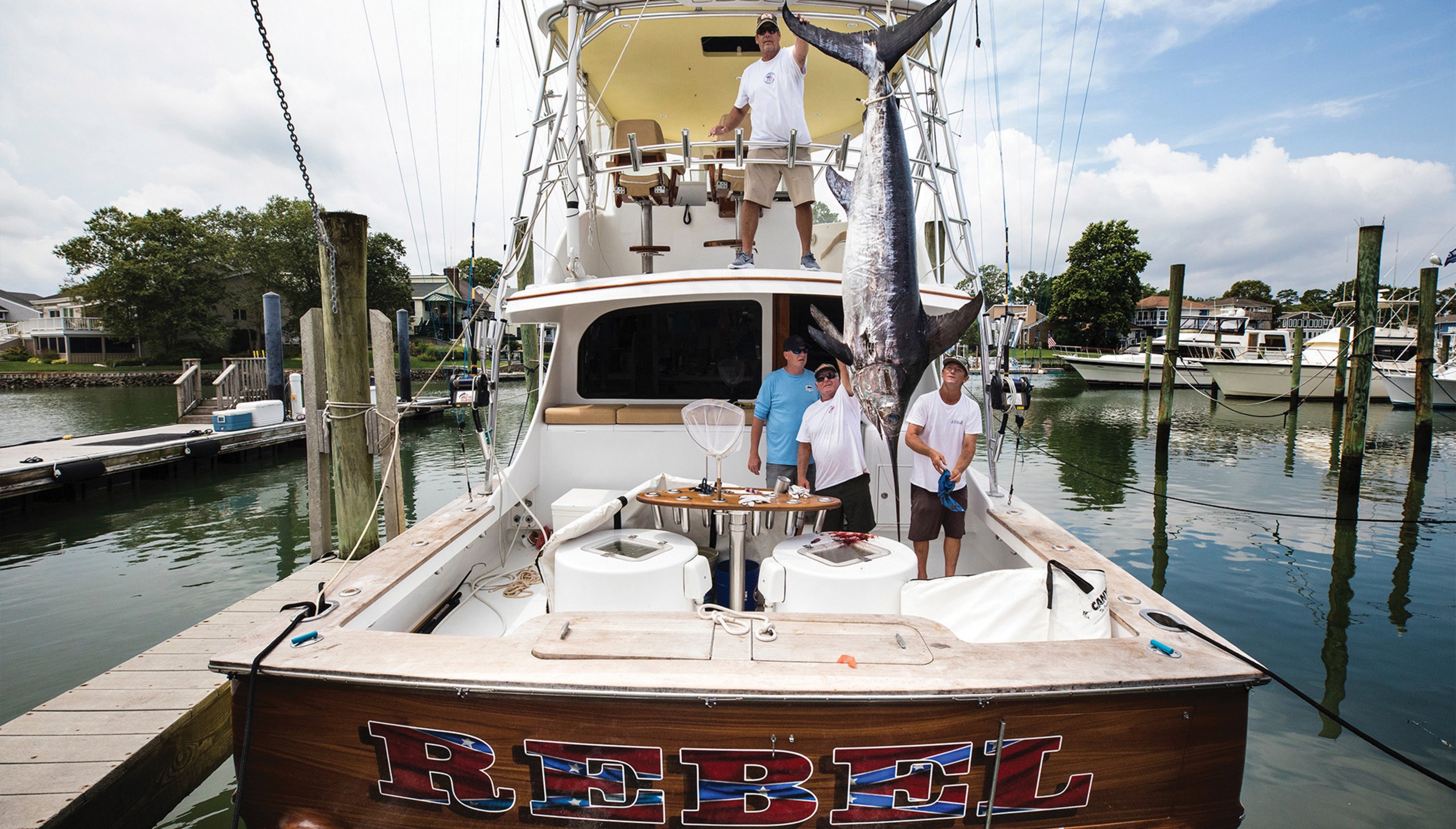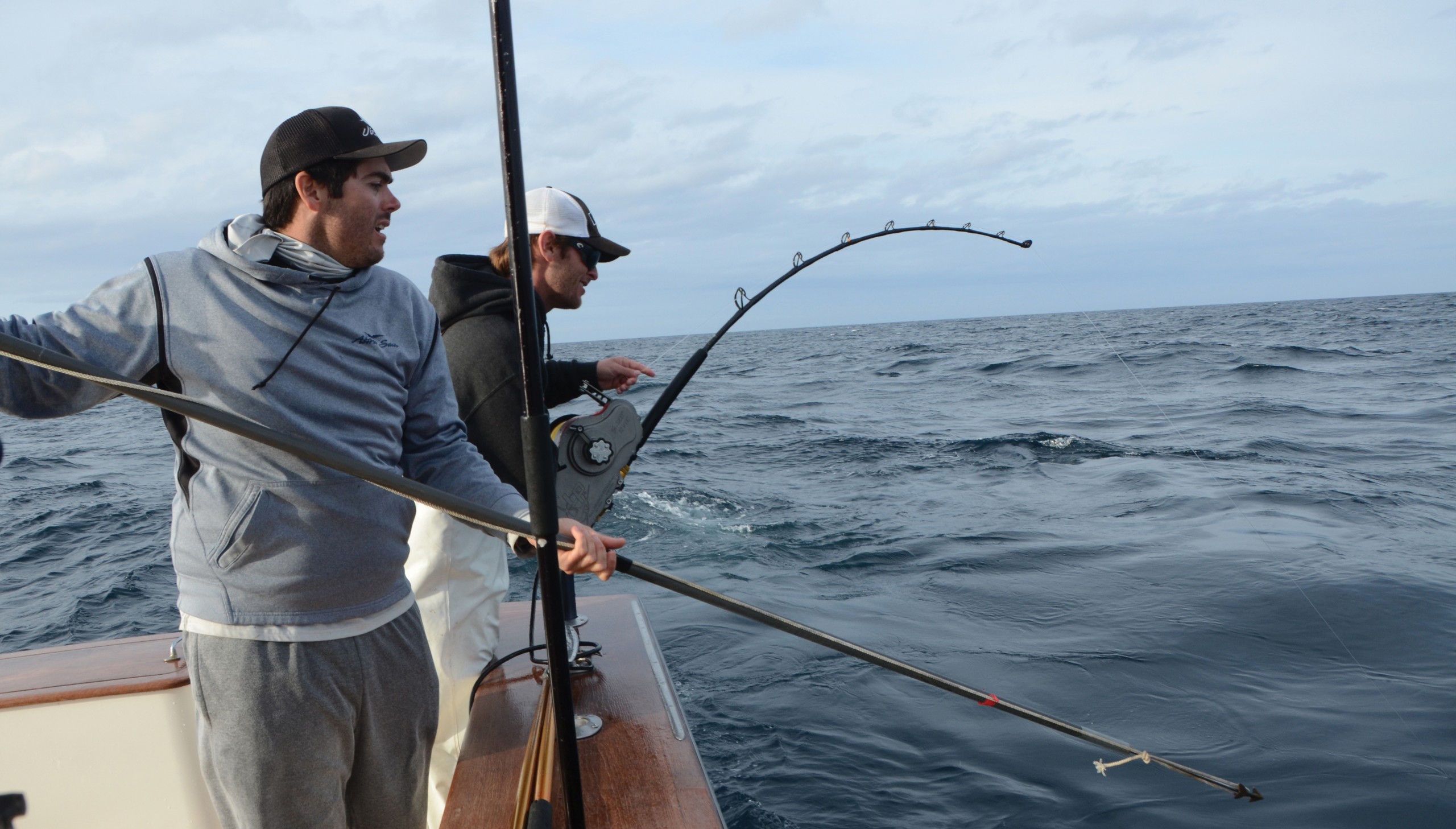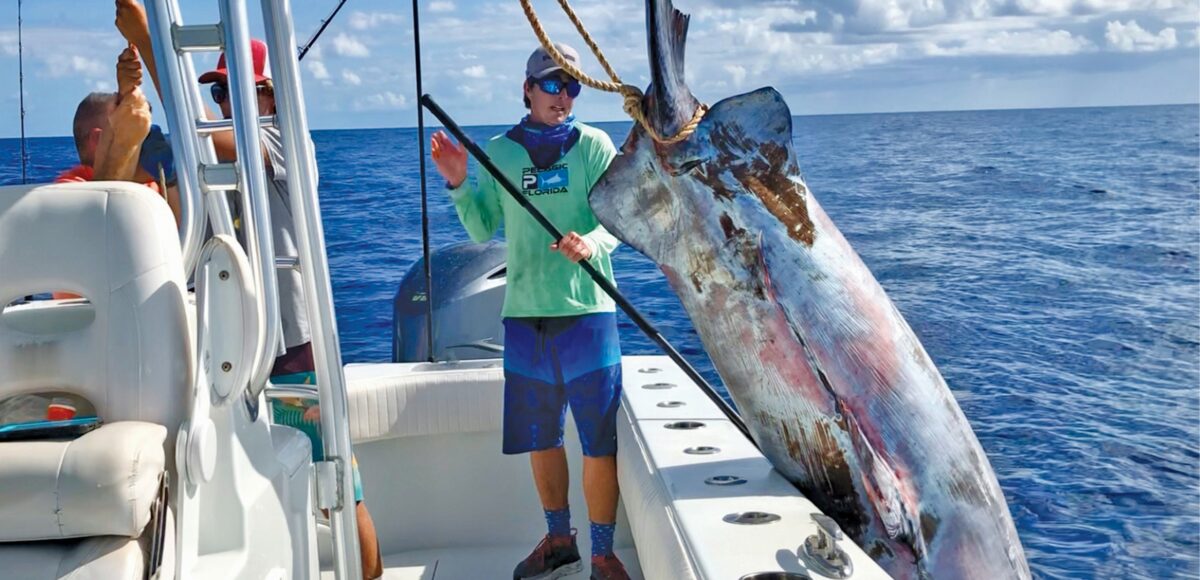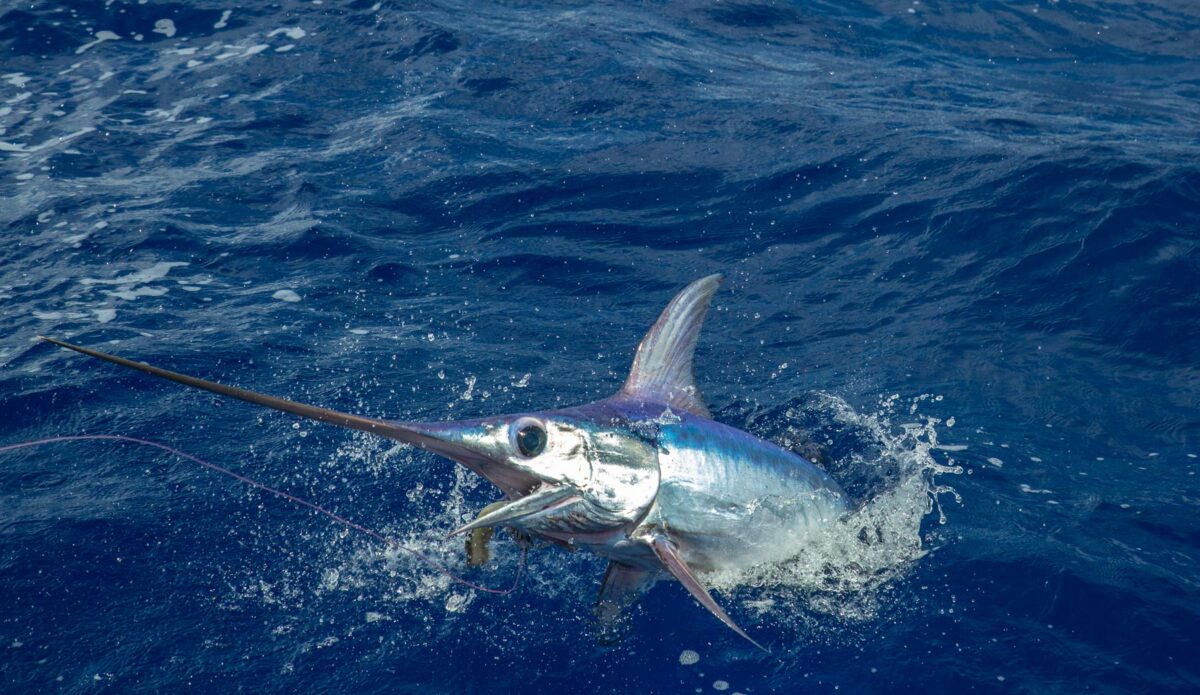Table of Contents
Somewhere in Southeast Asia, who knows how long ago, an angler in a canoe dangled a bait from a kite and kite fishing was invented. Centuries later, an angler in Japan installed a 30-foot-tall pole in his boat to suspend lures for tuna. The pole was painted green and called a “Greenstick”. Across the world, probably Latin or Central America, a captain ordered his crew to deploy 36 teasers on a metal frame to attract marlin.
Each of these discoveries proved to be so effective, word spread around the world. Today, kites, greensticks and dredges are used everywhere their target species swim. As the tactic spread, anglers have refined and improved the tackle and techniques.
More recently, an angler in South Florida dropped a bait 1500-feet and pulled up a swordfish. Word spread, and within a decade, anglers all over the world are copying their success and adapting it to their local conditions.
Captain Nick Stanczyk, Broad Minded Islamorada, Florida
Modern deep drop, daytime swordfishing is attributed to the Stanczyk team fishing out of Bud and Mary Marina in Islamorada, Florida. Captain Nick Stanczyk inherited the techniques from his father and uncle. They caught the first swordfish in 2003, I didnt see my first one till 2006.
Since then, Stanczyk has focused on swordfishing developing methods that have traveled around the world. He explains his addiction, Swordfish have a mystique, they’re elusive. He also says daytime fishing provides reliable action.
Stanczyk finds the fish in 1400- to 1800-feet of water along the steep canyons and large flats of the continental shelf. The most important factor is bait, he says. He looks for marks on his depth finder indicating life below the boat.
The standard rig for daytime swords starts with a heavy-duty, 50- to 80-pound rod and reel combo packed with 65-pound braided line. Stanczyk uses a 150-foot-long, 200-pound-test wind-on leader with a six-foot section of 300-pound test monofilament connected to a 9/0 to 11/0 J-hook. The eight- to 12-pound weight is attached to the leader with a floss loop a few feet from the mainline.
I hate squid, Stanczyk says. Instead, he prefers strip baits such as dolphin belly or bonita strips. He usually fishes two lines. A shallow bait dangles 900 feet from a buoy stationed 200 feet from the boat. This basic set-up, and its success on swordfish, have spread around the world. As word spread, crews adapted the techniques to their home waters.

Captain Jeff Wilson, Titan Up Galveston, Texas
Five years ago, Captain Jeff Wilson learned to daytime swordfish in Ft. Lauderdale. When he moved to Galveston, Texas, he took the lessons with him. We couldnt fish like we did in Fort Lauderdale, he remembers.
The Gulf Coast canyons, holes and crevices mimic the structure found off south Florida but the current doesnt move as fast. Wilson admits, We ended up with a tangled mess. To match conditions in the Gulf, he developed a C pattern for running the boat while dropping the bait, driving in an eighth-mile half-circle while dropping the rig.
They designed a unique rig, too. We developed a direct-drop method, Wilson explains. He starts with 80-pound braided mainline, theyve cut the 250-pound wind-on leader to 65 feet to a six-foot leader of 300-pound test.
Unlike Nick Stanczyk, Captain Wilson loves squid. For the best results, he stitches the squid to the Pakula 40 DHX hook. The hook has a longer barb and a beak point, he explains. Using 70-pound floss, he stitches the squid mantle to the head and uses a copper tube to keep the body from scrunching up on the hook. It looks like Frankenstein, he laughs, then insists he caught as many as three swords on one squid.
In another departure, Wilson clips a seven-pound sash weight directly to the hook with utility wire. Drop it to the bottom and bring it up quickly to knock the weight off, Wilson says. A smaller, cannonball weight, attached to the wind-on a few feet from the mainline connection, keeps the rig from spinning and tangling.
Wilson looks for bait and fish marks in 1300- to 1800-feet of water. 1500 feet is optimal, he says. Then, Wilson admits, We had two spots that produced half of our fish. He prefers to fish a week leading up to the full moon. The bite seems to drop off for five days following the full moon, he adds.
Wilson also fishes two lines, with one bait 1000- to 1200-feet below a buoy and the other a few hundred feet from the bottom. If I mark a DSL on the fishfinder, Ill drop the buoy to that depth, he adds, describing the deep scattering layer, a layer of small creatures that congregates between 1000- and 1500-feet deep.
He learned valuable lessons about hooking and fighting a swordfish. When Wilson gets a bite, he comes tight on the line then drives the boat ahead to drive the hook home. If the fish is going to come off, I want it to come off right away, he explains.
Adapting the South Florida technique to Gulf Coast, Wilson has scored more than 500 swordfish in five years. We used to get a lot of bites, he says. Recently, he noticed more anglers targeting day time swords and adds. Now we have to work for it, he says.

Captain Michael Maddox, SoCal Deep Drop Swordfishing Southern California
From South Florida to the East Coast and Gulf of Mexico, swordfishing is spreading like wildfire. Most recently, the fishery has flared up off of the coast of Southern California. Los Angeles angler, Mike Maddox has been commercial fishing for swordfish for the past couple years. But recently, there has been a big pick up in recreational fishing, he says.
According to Maddox, recreational swordfishing has picked up in the past few months around Anacapa, Catalina and Channel Islands. For two weeks people have been catching them a few miles off Newport Beach, he says.
Were fishing in 1200- to 1400-feet of water. He fishes one rod a couple hundred feet off the bottom and a buoy rod at 900-feet. I look for bait and thermocline on the meter, he says, adding there isnt much current so anglers just drop and fish.
The uptick in swordfish mania has inspired Maddox to sell rigged squid. I took what Ive learned commercial fishing and turned it to prepping baits for recreational anglers. He starts with an 18- to 24-inch squid and runs an 18/0 Mustad circle hook in through the tip of the mantle and out below the fins. To keep the bait in place, he simply zip ties it to the hook. I can use the same bait for two or three days, he says.
He attaches the bait to a six-foot section of 400-pound leader connected with a swivel to the 300-pound wind on leader running to 100-pound braided line. His ideal rod and reel combo
would be a bent-butt 80. The fishery is so new people are catching swords with whatever rods they have, he marvels.
Maddox has developed his own technique for hooking swordfish in deep water. When I see the rod tip bounce, I tell people to open a beer, he laughs. Maddox will wait for several minutes watching the rod tip bounce while the swordfish eats the bait.
When the line starts to plane out behind the boat, he knows the fish is hooked. He keeps the drag light and runs the boat forward to bring the fish to the surface. When the weight comes to the boat, he leaves it on the line while leadering the fish. If the fish takes another run, I let it take the weight to wear it down. Maddox continues to let the fish fight itself out. Dont put a lot of pressure on it, he stresses.
Maddox is amazed how fast daytime swordfishing has picked up in Southern California. People are just discovering the possibilities, he says. As anglers explore the canyons and cliffs, they are finding new places and new ways to catch swordfish.

Captain Randy Butler, Rebel Swordfishing Virginia Beach, Virginia
While daytime swordfishing is sweeping the world, it all started at night. To prove the point, last summer Virginia Beach charter captain Randy Butler and crew on Rebel set a new Virginia State Record with a 466-pound swordfish caught after dark.
Butler says the night-time challenge is greater. During the day the swordfish seem to be concentrated on the bottom, at night they spread out in the water column. To cover his bets, Butler fishes baits under floats at 20 and 60 fathoms and off the rod tip at 10 fathoms placing the deepest bait farthest from the boat.
He fishes the baits on a 10/0 to 11/0 hook crimped directly to the 200-foot, 200-pound wind-on. For bait, he likes what he finds locally. Butler often catches bullet tuna, tinker mackerel and squid in the lights under his boat. I like tinker mackerel, best, he admits.
In fact, Butler state record was caught on a tinker mackerel fished at 20 fathoms. Butler secret: he rigs the bait so the tail is up. Swordfish swallow the bait head first, so I get a better hook-up ratio he says.
He attaches a strobe five fathoms above the bait and fishes lights under the boat.
Butler focuses his fishing from 200 to 60 fathoms. Ive caught swords as shallow as 40 fathoms. He likes a north to south drift to carry him along the edge of the continental shelf. When he discovers a productive depth, hell focus his drift on that area.
Where ever anglers target swordfish, they adapt these techniques and baits to the water and fish in their area. Whether anglers have spent decades targeting swordfish or months, they admit they have much to learn and more fish to catch.

Want to Catch A Swordfish Call the Pros
To learn more about swordfishing, book a trip with these crews:
Rebel; Captain Randy Butler
Virginia Beach, Virginia
757-932-0036
Qualifier; Captain Fin Gaddy
Oregon Inlet, North Carolina
252-423-1779
Bud and Mary Marina; Captain Nick Stanzyk
Islamorada, Florida
305-482-0366
Rigged Baits; Mike Maddox
@SoCalDeepDrop
Don’t Forget to Check Out Our Sportfishing Job Board! Did You Know? It’s the perfect platform for seeking skilled captains and mates. Whether you’re on the hunt for your dream team or looking to join one, your next big adventure begins here. Explore the opportunities now! Click Here
Dive Deeper into the World of Sportfishing
Unlock Exclusive Savings: Enjoy 50% Off Your Subscription!
Are you ready to explore the thrilling world of sportfishing from the comfort of your home? Subscribe now and embark on a journey filled with captivating stories, expert insights, and insider tips. Choose between our digital or print edition and secure an incredible 50% discount on your subscription.
Subscribe today and get ready for an adventure like no other. Click here to subscribe and elevate your sportfishing experience with InTheBite Sportfishing Magazine.















